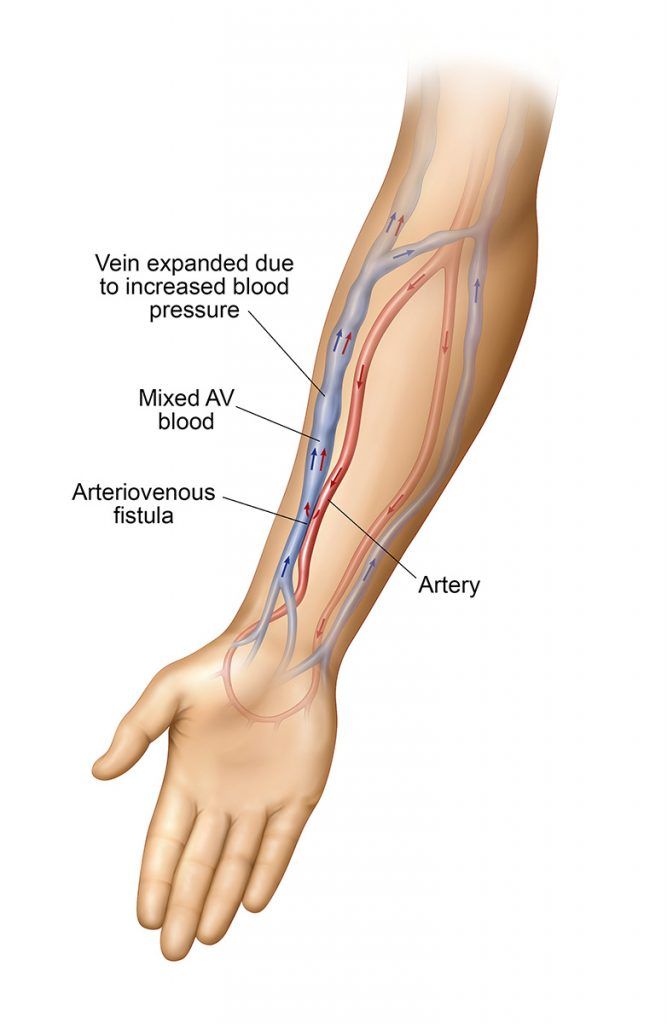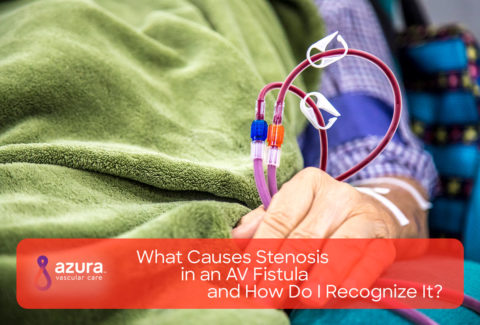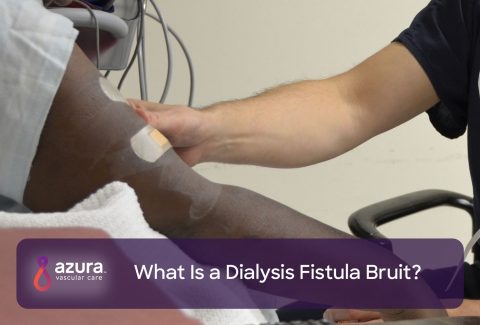
Has your doctor told you that you need to get an access for dialysis? If so, you’re probably wondering which of the types of dialysis access is best for you. The answer will depend on many factors. The arteriovenous (AV) fistula is often the best option, and considered “the gold standard” of hemodialysis access. In fact, by the end of the first year of treatment, 65% of patients receiving hemodialysis were using an AV fistula in 2015, according to the United States Renal Data System.ii
What is an AV Fistula?
 An AV Fistula is a surgical connection between one of your arteries and one of your veins. Most of the time, a fistula is created in your non-dominant arm, but it can also be placed in your leg if the arteries and veins in your arm are not large or healthy enough.
An AV Fistula is a surgical connection between one of your arteries and one of your veins. Most of the time, a fistula is created in your non-dominant arm, but it can also be placed in your leg if the arteries and veins in your arm are not large or healthy enough.
AV Fistula Creation Procedure
The AV fistula creation procedure is considered minor surgery and can be performed on an outpatient basis. The entire procedure usually takes about one hour to complete.
After you’ve been mildly sedated, your vascular specialist will use local anesthesia to numb the area in your arm or leg where the fistula will be created. Next, a small incision will be made in order to locate the vein and artery that will be used to create the fistula. Once they are located, the vein will be connected to the artery and the skin incision will be sutured closed.
AV fistulas need time to heal and mature completely before they can be used as a dialysis access.
Who Can Get an Arteriovenous Fistula?
If your veins are healthy and you don’t need immediate dialysis, an AV fistula will likely be your best option for a dialysis access. Even if you need immediate dialysis, your doctor may still suggest that you consider having an AV fistula created for long-term treatment.
To determine whether your veins are healthy enough and large enough for an AV fistula, you will need to have a procedure, known as vessel mapping, performed. This can be done using an ultrasound machine or by injecting contrast dye into your veins while under fluoroscopy (a type of x-ray) so an image, or map of your veins, can be obtained and evaluated.
AV Fistula Maturation Time
After surgery, you may experience some pain, swelling and bruising near your access site for a few days. This is normal. You may also notice a vibration coming from your access site. This is called a “thrill,” and it, too, is normal. In fact, over the first week following your surgery, this thrill will strengthen.
Before your AV fistula can be used, it needs time to mature. This can take 4 ½ months, on average.iii
AV Fistula Care
An arteriovenous fistula requires daily inspection and care. You need to clean it every day with antimicrobial soap and water, and you’ll want to avoid sleeping on it. You need to look, listen and feel for signs that your AV fistula is functioning properly.
Look – Look at your access to check for signs of infection – swelling, redness, warmth and drainage are all signs to watch for. Also note if there are any changes to the skin, such as bleeding, bulging or peeling.

Listen – Put your ear to your arm (or leg) and listen for the sound of blood flowing through your fistula.

Feel – Put your hand on your access to feel the “thrill.” Any change in the feel of the vibration, or an absence of vibration is cause for concern. If there is no vibration or thrill you should notify your doctor immediately.

Advantages of an AV Fistula

Your AV fistula will allow more blood to flow through your vein at a faster rate and therefore will increase the pressure within the vein. This increased venous pressure stretches and strengthens the vein, allowing more blood to flow back and forth from your vein to the dialyzer.
There are many advantages to an AV fistula, including:
- AV fistulas are created from your body. There are no artificial components used.
- They can function for years.
- They’re not as likely as a catheter to become infected or clotted.
- They are often easier to maintain than other access options.
- AV fistulas provide good blood flow to the dialyzer, and may reduce the prescribed dialysis treatment time.
Disadvantages of an AV Fistula
Like any of your options for dialysis access, an arteriovenous fistula is not without their disadvantages. But these drawbacks are fairly minor compared to the problems often associated with other access types, such as a central venous catheter (CVC).iv The main disadvantages of having an AV fistula can be:
- If you need dialysis right away, you will need a temporary access that can be used while your AV fistula is healing and maturing.
- Healing can sometimes take longer than expected, or the access may fail to mature.
- Needles are required to access the AV fistula for dialysis.
Taking care of your AV fistula is critical. Your dialysis access is your lifeline to good health, and with proper care once it’s fully mature, you can expect your AV fistula to continue to function well.
Sources:
i National Kidney Foundation. Accesses from: https://www.kidney.org/sites/default/files/Fistula%20Bulletin.pdf
ii United States Renal Data System. Accessed from: https://www.usrds.org/2015/view/v2_04.aspx?zoom_highlight=fistula%20at%20initiation
iii Morsy, A.H., Kulbaski, M., Chen, C., Isiklar, H., Lumsden, A.B.(1998) Incidence and characteristics of patients with hand ischemia after a hemodialysis access procedure. Journal of Surgical Research 74(1): 8-10.
iv Kornbau, C., Lee, K. C, Hughes, G. D., and Firstenberg, M.S. (2015) Central line complications. International Journal of Critical Illness and Injury Science 5(3): 170–178.


